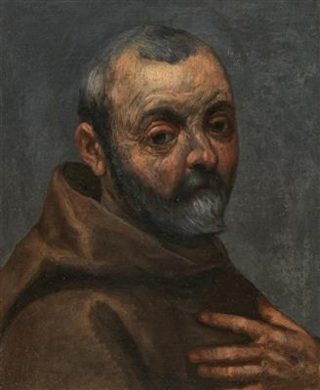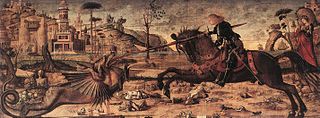History
Since the early Middle Ages, Venice had intense commercial relationships with Dalmatia, which became even stronger when the whole region was conquered by Venice in the early 15th century. In the city, Slavic immigrants from Dalmatia were called Schiavoni . They formed a brotherhood, approved by the Consiglio dei Dieci in 1451.
Mostly sailors and workers, they initially met on a ground near the church of San Giovanni di Malta. Their patron saints were Sts. George, Jerome and Tryphon, joined by St. Matthew when the brotherhood received a relic of that saint in 1502. In that period the corporation bought the former hospital of St. Catherine in the area, and restored as its Scuola, under design by Giovanni De Zan with a façade inspired by Jacopo Sansovino. From 1502 to 1507 the painter Vittore Carpaccio was commissioned seven panels with the Stories of the Patron Saints of the Scuola, which are still in the building. Other rooms have paintings, decorations and embellishments.
Description
Externally, over the entrance is a relief with St. George Killing the Dragon (1552), by Pietro di Salò and, above it, a "Virgin Enthroned with Saints" (mid-14th century) by a Venetian sculptor.
The ground hall has on its four walls the paintings commissioned to Carpaccio, inspired by Jacobus de Voragine's Golden Legend:
There are also two evangelic depictions, also by Carpaccio:
The upper hall (Sala dell'Albergo) has a wooden ceiling with painted decorations by Bastian de Muran, and, on the walls, other paintings of Jacopo Palma the Younger school. At the altar is a Patron Saint of the Scuola with, at its sides, two gilt panels of St. Jerome and St. Tryphon (15th century)

Vittore Carpaccio (UK: /kɑːrˈpætʃ oʊ/, US: /-ˈpɑːtʃ-/, Italian: [vitˈtoːre karˈpattʃo]; was an Italian painter of the Venetian school who studied under Gentile Bellini. Carpaccio was largely influenced by the style of the early Italian Renaissance painter Antonello da Messina, as well as Early Netherlandish painting. Although often compared to his mentor Gentile Bellini, Vittore Carpaccio's command of perspective, precise attention to architectural detail, themes of death, and use of bold color differentiated him from other Italian Renaissance artists. Many of his works display the religious themes and cross-cultural elements of art at the time; his portrayal of St. Augustine in His Study from 1502, reflects the popularity of collecting "exotic" and highly desired objects from different cultures.

The Gallerie dell'Accademia is a museum gallery of pre-19th-century art in Venice, northern Italy. It is housed in the Scuola della Carità on the south bank of the Grand Canal, within the sestiere of Dorsoduro. It was originally the gallery of the Accademia di Belle Arti di Venezia, the art academy of Venice, from which it became independent in 1879, and for which the Ponte dell'Accademia and the Accademia boat landing station for the vaporetto water bus are named. The two institutions remained in the same building until 2004, when the art school moved to the Ospedale degli Incurabili.

The Volpino Italiano or Volpino is an Italian breed of dog of Spitz type. It is closely related to the Pomeranian and to the German Spitz.

Iacopo Negretti, best known as Jacopo or Giacomo Palma il Giovane or simply Palma Giovane, was an Italian painter from Venice and a notable exponent of the Venetian school.

San Giorgio Maggiore is a 16th-century Benedictine church on the island of the same name in Venice, northern Italy, designed by Andrea Palladio, and built between 1566 and 1610. The church is a basilica in the classical Renaissance style and its brilliant white marble gleams above the blue water of the lagoon opposite the Piazzetta di San Marco and forms the focal point of the view from every part of the Riva degli Schiavoni.

The Scuola Grande di San Marco is a building in Venice, Italy, designed by the well-known Venetian architects Pietro Lombardo, Mauro Codussi, and Bartolomeo Bon. It was originally the home to one of the Scuole Grandi of Venice, or six major confraternities, but is now the city's hospital. It faces the Campo Santi Giovanni e Paolo, one of the largest squares in the city.

Castello is the largest of the six sestieri of Venice, Italy.
Events from the year 1507 in art.

The Madonna dell'Orto is a church in Venice, Italy, in the sestiere of Cannaregio. This was the home parish of Tintoretto and holds a number of his works as well as his tomb.
Matteo Ponzone was an Italian painter of the Baroque period, active between 1630 and 1700 mainly in Venice. He was a pupil of Santo Peranda. Several of his works are in the churches and public buildings of Venice, particularly in San Giorgio Maggiore, and in the church of the "Padri Croceferi".

The Scuola Grande di San Giovanni Evangelista is a confraternity building located in the San Polo sestiere of the Italian city of Venice. Founded in the 13th century by a group of flagellants it was later to become one of the five Scuole Grandi of Venice. These organisations provided a variety of charitable functions in the city as well as becoming patrons of the arts. The Scuola Grande di San Giovanni Evangelista is notable for housing a relic of the true cross and for the series of paintings it commissioned from a number of famous Venetian artists depicting Miracles of the Holy Cross. No longer in the school, these came into public ownership during the Napoleonic era and are now housed in the Gallerie dell'Accademia. The scuola is open to visitors on a limited number of days, detailed on the official website.

St. Augustine in His Study is an oil and tempera on canvas painting by the Italian Renaissance artist Vittore Carpaccio housed in the Scuola di San Giorgio degli Schiavoni of Venice, northern Italy. The painting depicts St. Augustine while he has a vision while sitting in a large room filled with objects. The study, or studiolo, that was a one way that Italian aristocrats and collectors that displayed wealth, power, taste, and worldly knowledge. Carpaccio intentionally opens up the study to the viewer, revealing a vast amount of objects that have different origins and meanings. The artist signed the work on the small plaque, or cartellino, in the foreground near the dogs that reads: "VICTOR / CARPATHIVS / FINGEBAT".

St. George and the Dragon is a tempera on canvas painting by the Italian Renaissance artist Vittore Carpaccio. It is housed in the Scuola di San Giorgio degli Schiavoni of Venice, northern Italy.

The Procession in St. Mark's Square is a tempera-on-canvas painting by Italian Renaissance artist Gentile Bellini, dating from c. 1496. It is housed in the Gallerie dell'Accademia in Venice.

The Scuola di Santa Maria degli Albanesi was a confraternity, a Scuola Piccola, for Albanian Christians Catholics, in Venice, northern Italy. Its building subsists.

The Riva degli Schiavoni is a monumental waterfront in Venice. It is located in the sestiere of Castello and extends along the San Marco basin in the stretch from the Ponte della Paglia bridge, close to the Doge's Palace to the rio di Ca' di Dio.

The Galleria Giorgio Franchetti alla Ca' d'Oro is an art museum located in the Ca' d'Oro on the Grand Canal in Venice, Italy.
Save Venice Inc. is a U.S. non-profit organization dedicated to the conservation of art and architecture and the preservation of cultural heritage sites in Venice, Italy. Headquartered in New York City, it has an office in Venice, a chapter in Boston, and supporters across the United States and Europe.
Life of the Virgin is a cycle of six large canvases by Vittore Carpaccio, dating to between 1504 and 1508. Originally painted for the sala dell'Albergo in the Scuola di Santa Maria degli Albanesi in Venice, they are now split between several museums. They are mostly in oil, though some of them are in mixed technique.
This is an alphabetical index of people, places, things, and concepts related to or originating from the Republic of Venice. Feel free to add more, and create missing pages.
















